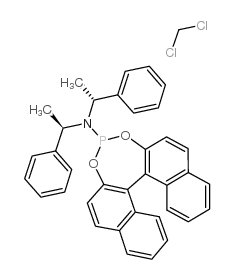415918-91-1
| Name | (s)-(+)-(3,5-dioxa-4-phospha-cyclohepta[2,1-a:3,4-a']dinaphthalen-4-yl)bis[(1r)-1-phenylethyl]amine,dichloromethane adduct |
|---|---|
| Synonyms |
3,4-a']dinaphthalen-4-yl)bis[(1R)-1-phenylethyl]aMine
(S,R,R)-(+)-(3,5-Dioxa-4-phosphacyclohepta[2,1-a (S,R,R)-(+)-(3,5-DIOXA-4-PHOSPHA-CYCLOHE MFCD08561138 (+)-N,N-Bis[(1R)-1-phenylethyl]-dinaphtho[2,1-d:1 |
| Boiling Point | 710.7ºC at 760 mmHg |
|---|---|
| Melting Point | 102-103ºC |
| Molecular Formula | C37H32Cl2NO2P |
| Molecular Weight | 624.53500 |
| Flash Point | 383.6ºC |
| Exact Mass | 623.15500 |
| PSA | 29.52000 |
| LogP | 12.47830 |
|
Section 1: Product Identification (S)-(+)-(3,5-Dioxa-4-phospha-cyclohepta[2,1-a;3,4-a']dinaphthalen-4-yl)bis[(1R)-1-phenylethyl]amine, Chemical Name: dichloromethane adduct, min. 95% CAS Registry Number:415918-91-1 Formula:C36H30NO2P EINECS Number:none
Chemical Family:Phosphoramidite Synonym:none Section 2: Composition and Information on Ingredients IngredientCAS NumberPercentACGIH (TWA)OSHA (PEL) Title Compound415918-91-1100%no datano data Section 3: Hazards Identification Emergency Overview:Irritating to the respiratory tract, skin and eyes. May be harmful if swallowed. Primary Routes of Exposure:Ingestion, eyes, inhalation Eye Contact:Causes moderate irritation of the eyes. Skin Contact:Causes slight to mild irritation of the skin. Inhalation:Irritating to the nose, mucous membranes and respiratory tract. Ingestion:May be harmful if swallowed. No specific information is available on the physiological effects of ingestion. Acute Health Affects:Irritating to skin, eyes and respiratory tract. Chronic Health Affects:No information available on long-term chronic effects. NTP:No IARC:No OSHA:No SECTION 4: First Aid Measures Immediately flush the eyes with copious amounts of water for at least 10-15 minutes. A victim may need Eye Exposure: assistance in keeping their eye lids open. Get immediate medical attention. Wash the affected area with water. Remove contaminated clothes if necessary. Seek medical assistance if Skin Exposure: irritation persists. Remove the victim to fresh air. Closely monitor the victim for signs of respiratory problems, such as difficulty Inhalation: in breathing, coughing, wheezing, or pain. In such cases seek immediate medical assistance. Seek medical attention immediately. Keep the victim calm. Give the victim water (only if conscious). Induce Ingestion: vomiting only if directed by medical personnel. SECTION 5: Fire Fighting Measures Flash Point:none Autoignition Temperature:none Explosion Limits:none Extinguishing Medium:carbon dioxide, dry powder or foam Fire fighters should be equipped with a NIOSH approved positive pressure self-contained breathing apparatus Special Fire Fighting Procedures: and full protective clothing. Hazardous Combustion andIf involved in a fire this material may emit toxic organic fumes and vapors of phosphorus pentoxide. Decomposion Products: Unusual Fire or Explosion Hazards: No unusual fire or explosion hazards. SECTION 6: Accidental Release Measures Small spills can be mixed with vermiculite, sodium carbonate or other suitable non combustible adsorbent and Spill and Leak Procedures: swept up. SECTION 7: Handling and Storage Keep material in a tightly sealed container. Prolonged exposure to moisture will result in degradation of the Handling and Storage: product. Handle and store material under a dry atmosphere. SECTION 8: Exposure Controls and Personal Protection Eye Protection:Always wear approved safety glasses when handling a chemical substance in the laboratory. Skin Protection:Wear protective clothing and gloves. Consult with glove manufacturer to determine the proper type of glove. Ventilation:Material may form a fine dust. If possible, handle the material in an efficient fume hood. If ventilation is not available a respirator should be worn. The use of respirators requires a Respirator Respirator: Protection Program to be in compliance with 29 CFR 1910.134. Ventilation:Material may form a fine dust. If possible, handle the material in an efficient fume hood. Additional Protection:No additional protection required. SECTION 9: Physical and Chemical Properties Color and Form:white pwdr. Molecular Weight:539.6 Melting Point:102-103° Boiling Point:no data Vapor Pressure:not applicable Specific Gravity:no data Odor:none Solubility in Water:reacts slowly with water SECTION 10: Stability and Reactivity Stability:air stable, moisture sensitive Hazardous Polymerization:no hazardous polymerization Conditions to Avoid:extended exposure to moisture and acids Incompatibility:oxidizing agents Decomposition Products:carbon monoxide, phosphorus pentoxide, nitrogen and nitrogen oxides, and organic fumes. SECTION 11: Toxicological Information RTECS Data:No information available in the RTECS files. Carcinogenic Effects:no data Mutagenic Effects:no data Tetratogenic Effects:no data SECTION 12: Ecological Information Ecological Information:No information available SECTION 13: Disposal Considerations Disposal:Dispose of according to federal, state, and local regulations. SECTION 14: Transportation Shipping Name (CFR):Non-hazardous Hazard Class (CFR):NA Additional Hazard Class (CFR):NA Packaging Group (CFR):NA UN ID Number (CFR):NA Shipping Name (IATA):Non-hazardous Hazard Class (IATA):NA Additional Hazard Class (IATA):NA Packaging Group (IATA):NA UN ID Number (IATA):NA SECTION 15: Regulatory Information TSCA:Not listed in the TSCA inventory. SARA (Title 313):Title compound not listed. Second Ingredient:none SECTION 16 - ADDITIONAL INFORMATION N/A |
